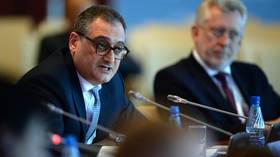Battlefields contaminated with depleted uranium bred cancer plague
Depleted uranium has been used for nearly 20 years as sub-ammunition of artillery shells in international conflicts like the two Iraq Wars and the NATO conflict with Serbia, but the long-term effects of it are unknown.
In Iraq, many doctors believe that the radiation leaked from old weapons used by foreign forces in 1991 and 2003 are continuing to have a deadly impact.
They fear that the remains of the substance are spreading cancer through the population and contaminating water.
Seven years after the invasion of Iraq, people there are still dying from its after-effects.
In cities and towns across the country, old munitions are leaking radiation, with horrific consequences.
“The number of cancer cases among children increased by 227 per cent in the period from 2005 to 2007,” stated Doctor K. Suleiman. “Experts at the University of Basra Research Center claim that toxic agents will continue having a harmful effect on human health for the next 50 years.”
During the Gulf War in 1991 and the invasion of Iraq in 2003, coalition forces fired thousands of “depleted uranium” shells.
Depleted uranium is a by-product of the enrichment process and its immense density makes it a powerful projectile. But it can leave a deadly legacy.
“Depleted uranium, which was used back in 1991 and 2003, is the most dangerous substance. Experts reckon that over 350 tonnes of it were used in total. This substance will give out harmful radiation for years into the future,” predicted Dr. Suleiman. “For instance, as many as 35 new forms of cancer not known to the World Health Organization were reported in June 2008.”
Two reports, one by the US army and the other by the World Health Organization, warned about the dangers of depleted uranium before the 2003 war.
When shells fell into the dust, they contaminated it, along with water sources nearby.
And when it is inhaled or drunk, radioactive material can sit in the body, damaging DNA and leading to cancer.
The Head of a humanitarian organization for children with cancer, L. Shakir, informs that “The reports say that the number of cancer patients is growing. But some doctors say it’s all within the norm and that the number of cancer cases here is smaller than in other countries. We need to consolidate our efforts in fighting cancer. The support of the state, represented by the Health Minister, is of paramount importance, as is the role of NGOs and international organizations.”
Officially, the US army is skeptical about the link between depleted uranium shells and cancer rates.
But where battles were fought, Iraqi doctors are struggling to cope with huge rises in numbers of tumors and birth defects and, for them, the link is obvious.
“2,000 new cancer cases are reported in Basra annually. Our patients come from Basra, An-Nasiriyah, Amara and other provinces,” Doctor Jivad Ali, an oncologist, said.













